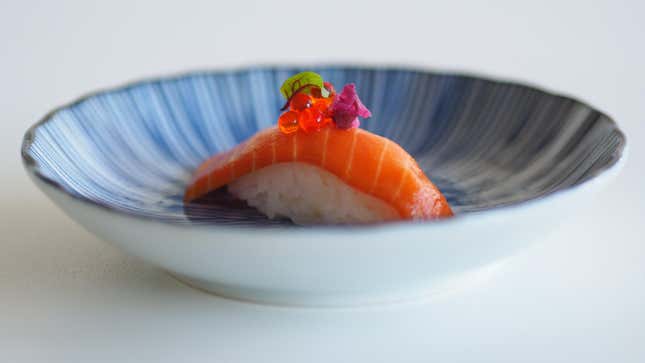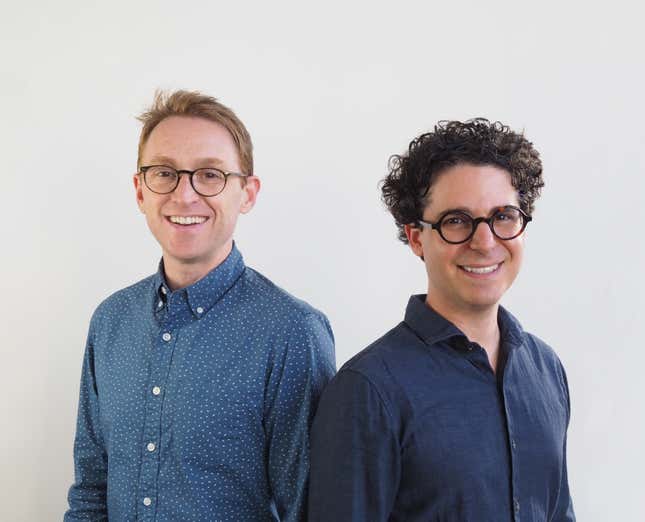
The global seafood situation is probably worse than you think. Per the NOAA Fisheries 2020 Status of Stocks report, federally managed fish stocks are experiencing a severe uptick in overfishing. Meanwhile, scientists suspect that deep sea trawling could release as much carbon into the atmosphere as the entire aviation sector—93% of which is stored directly in the rapidly-heating ocean. Those factors, combined with exponential global population growth, could spell disaster for both wild and farmed seafood availability. Are you worried yet?
But wait! Now there’s cellular agriculture, the practice of boosting the global food supply with animal protein grown from non-sentient cells in a lab.
It works like this: first, scientists extract muscle cells from live animals in a non-invasive, slaughter-free procedure. Scientists then cultivate the cells, placing them in a structural mesh and feeding them a blend of essential vitamins and sugars. Eventually, the cells form sheets of muscle tissue and fat. The result is real animal protein with all of the flavor, but none of the carnage—environmental or otherwise.
Cell-cultured meat may seem like a far-off prospect, a Jetsons-level protein source only available in a grim, distant future. But a small group of companies is already working to make cell-grown meat a reality for the average consumer. San Diego-based company BlueNalu focuses on cell-grown fish, while the Singapore startup Shiok Meats creates cultivated shrimp meat from microscopic crustacean cells. Nestlé also recently announced plans to invest in the lab-grown meat space.
But one cellular agriculture startup will soon put cell-grown protein in front of consumers, with plans for a wide-scale release that could revolutionize the seafood industry. That company is Wildtype, a San Francisco startup that cultivates salmon without relying on wild or farmed fish.
Wildtype’s website reads: “With so much new demand on our food supply, we need to create new tools to sustainably meet the environmental and food security challenges of our 21st century.” In a phone interview, Wildtype co-founder and CEO Justin Kolbeck explains a few of those challenges.
“The future of salmon farming is such that we’re running out of coastline,” Kolbeck tells me. With limited space, salmon farmers have begun to turn to unsustainable methods—Atlantic salmon farmed in the Pacific, for example. Wildtype co-founder and and chief scientist Aryé Elfenbein adds that farmers are also opting for energy-intensive on-land facilities. “It’s the equivalent of growing chickens under the ocean, in terms of how energy-intensive it is,” Elfenbein says. “We just cannot separate seafood production from the climate problem,” Kolbeck concludes. “They’re inextricably linked.”
Elfenbein and Kolbeck met at a dinner party a decade ago. They immediately bonded over their shared passions, which include food, tech innovation, and fighting climate change. Before this, Kolbeck had served as a diplomat in Afghanistan’s Paktika province, an area with a significant food-insecure population. “I left that experience really worried about the future of food generally,” Kolbeck says, adding that the global population is slated to reach nearly 10 billion by the middle of this century. “So if our population’s going to grow to 10 billion, and all 10 billion of those people want to eat a lot more meat and seafood and poultry, where are all those natural resources going to come from?”
Meanwhile, Elfenbein had just returned from a visit to northern Australia, where he grew up. “I saw places that used to be rainforest and now are used for cattle farming, which was really startling,” Elfenbein says. Around the time of the dinner party, Elfenbein was engaged in cardiac regenerative therapeutics, working to restore damaged heart tissue through stem cells and other reparative means. “As I was making these little beating heart tissues in a dish, I was still thinking about how [this method] could be applied way beyond the medical sciences,” he says.

Meanwhile, in the Netherlands, physician and self-described tissue engineer Mark Post was designing the world’s first cell-cultivated hamburger. Kolbeck and Elfenbein had an idea: what if they could do the same thing with fish? “What if we could create a seafood product without the ocean contaminants—the mercury and the microplastics and the antibiotics that are sadly part of almost every piece of fish that we buy today?” Elfenbein remembers asking. “And what if we could do it for the price of chicken in 10 years, making a sushi dinner one of the more accessible meals that you can have?”
Thus, Wildtype was born. It was a great idea—just not an easy one to execute. The company’s first challenge: scientists don’t know as much about the way that fish cells grow compared to mammalian or avian species. That meant the Wildtype team had to determine salmon cells’ ideal growth conditions—everything from the weight of the structural mesh to temperature, nutrients, and minerals—entirely from scratch.
Then, of course, the finished product had to taste good. “We’re working with more subtle textures and complex flavors than [are present in] chicken or beef,” Kolbeck says. “We had to figure out what is it within these fish cells that contributes to all of the unique flavors that create this completely unmistakable flavor profile of something like salmon.” The team also had to figure out how to structure the cells to create salmon’s unique fatty texture. Finally, and perhaps most importantly, they had to do all of this without slaughtering actual fish, a feat they proudly achieved.
“It’s been about two years now since we’ve even had to even look at a fish,” Elfenbein says, laughing. “Animals are not part of the production process. So if you care about animal rights, if you care about ethical harvest and slaughter practices, this product is for you.” To be clear, this isn’t a vegan product—Wildtype manufactures real salmon, with real salmon cells with real salmon DNA. But the cells only need to be drawn from a fish once, meaning the salmon could then theoretically return to the water whence it came. The cells also don’t form a sentient creature; there are no organs, and the product doesn’t have a brain. It’s just a slab of meat.
Of course, plenty of plant-based eaters have other reasons for avoiding meat. Some dislike the taste; others wrinkle their noses at the idea of consuming animal flesh, be it slaughtered or cultivated. Some could also argue that cell-cultured meat is simply a distraction—a misguided use of energy in a burning world. One could conclude that scientists should focus their energies on more approachable plant-based alternatives, especially when communities that are likely to be hit the hardest by climate change probably won’t have access to cell-cultured salmon any time soon. Then again, it’s hard to ignore the fact that, climate change or no climate change, most meat eaters aren’t interested in ditching animal proteins.
To reach all those ardent carnivores, Wildtype has to grow the salmon cells at a totally unprecedented scale. Elfenbein and Kolbeck cite a few industries that serve as inspiration, including the beer brewing, which involves shepherding countless yeast cells.
But despite the many hurdles, Wildtype is already conducting taste tests. Elfenbein notes that a gaggle of college students recently sampled a poke bowl made with Wildtype salmon, and they were unable to distinguish the cultivated fish from the traditionally harvested fish. “I love watching people eat this product, because, on the one hand, their mind is telling them, ‘Whoa, this is crazy,’” Elfenbein says. “We get to see that idea—that this didn’t actually come from a fish—be disassembled as they recognize those flavors. There’s this moment of familiarity that overrides the novel way of producing these products.”
With this in mind, Kolbeck predicts that cell-cultured meat could become widely accepted in the same way as meatless fast food alternatives. “When the Impossible Whopper came on the scene, customers thought, ‘Yeah, this is from plants—but I’m still getting that Whopper satisfaction,” he says. “Consumers are getting used to the idea of enjoying food while also casting a vote in favor of a cooler and greener planet.”
In the meantime, Wildtype hopes to educate consumers with a new pilot production facility, which will likely become the world’s first cell-cultivated protein tasting room. The space, slated to open in San Francisco in late summer or early fall of this year, will serve as both a tasting room and education center. At the same time, Elfenbein notes that Wildtype is working to scale up operations to the point where they’re beginning to select restaurant partners. “The pilot production facility is, in a sense, a large experiment so we can figure out how, exactly we achieve that scale,” Elfenbein says.
In a perfect world, every large city around the globe might have a cell-cultured meat facility. In 2019, NPR reported on Wildtype competitor BlueNalu, a company working toward “a future where cities around the globe will be home to 150,000-square-foot facilities, each able to produce enough cell-based seafood to meet the consumption demands of more than 10 million nearby residents.” For now, cultivated salmon remains a bit of a novelty, albeit an intriguing one. But until companies like Wildtype can produce a product that’s accessible to the general public, coastal ecosystems will pay the price.